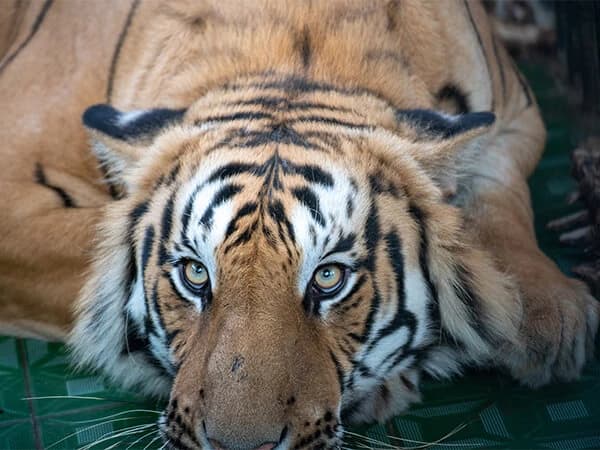Why Nepal’s Biodiversity is So Special
Nepal is home to some of the world’s most unique ecosystems. From the subtropical forests of the Terai to the alpine meadows of the Himalayas, the country’s rich landscape provides the perfect backdrop for spotting rare animals. Conservation efforts in these areas ensure that future generations can continue to enjoy Nepal’s natural beauty without harming its fragile environment.
Top Wildlife Species to Spot
One of the main reasons people embark on a wildlife safari in Nepal is to catch a glimpse of its iconic species. Here’s a list of must-see wildlife when exploring the country’s natural wonders.
Bengal Tiger
Nepal is one of the few places in the world where you can witness the majestic Bengal tiger in the wild. These apex predators are often seen in Chitwan and Bardia National Parks, roaming through the dense forests and tall grasslands. Spotting a Bengal tiger in its natural habitat is a heart-racing experience for any wildlife lover.
One-Horned Rhino
The greater one-horned rhinoceros, also known as the Indian rhino, is one of the most significant conservation success stories in Nepal. Once on the brink of extinction, these magnificent creatures now thrive in Chitwan National Park, making it one of the best places to view them in Asia.
Asian Elephant
The Asian elephant is another species commonly spotted on Nepal’s wildlife safaris. Known for their intelligence and strong familial bonds, these elephants can be seen roaming in large herds, particularly in Bardia National Park. Visitors can observe their behavior up close, especially during the dry season when they gather near water sources.
Birdlife
Nepal is a birdwatcher’s paradise, with over 900 species of birds. From colorful pheasants to the endangered Himalayan Monal, the country’s avifauna is as diverse as its landscapes. Both Chitwan and Sagarmatha National Parks are prime spots for birdwatching, where you can encounter species like the Rufous-necked Hornbill or the White-rumped Vulture.
Best National Parks for Safaris
If you’re planning a wildlife safari in Nepal, here are the top national parks where you’ll find the best chances to spot the region’s diverse species.
Chitwan National Park
Chitwan National Park is the most famous national park in Nepal and a UNESCO World Heritage Site. Located in the lowland Terai region, it’s home to a stunning variety of animals, including Bengal tigers, one-horned rhinos, leopards, and sloth bears. The park also offers jeep safaris, canoe rides, and jungle walks to provide an intimate experience with the wildlife.
Bardia National Park
For those looking for a more off-the-beaten-path experience, Bardia National Park offers incredible wildlife spotting opportunities with fewer crowds. Known as Nepal’s best-kept secret, this park is home to tigers, elephants, and gharial crocodiles. The park’s remoteness makes it ideal for those who want a quiet, immersive wildlife safari.
Sagarmatha National Park
While primarily known for Mount Everest, Sagarmatha National Park also offers a unique wildlife experience. As you trek through this high-altitude park, you might encounter snow leopards, musk deer, and an incredible array of birdlife, including the Himalayan griffon. Combining a trek with wildlife observation here is a once-in-a-lifetime opportunity.
Types of Safaris in Nepal
Nepal offers a range of safari options that cater to all types of travelers. Here are some of the best ways to explore Nepal’s wildlife.
Jeep Safari
A jeep safari is the most comfortable way to explore the national parks. These safaris allow you to cover large areas of terrain and provide a better chance of spotting elusive animals like tigers and rhinos. Chitwan National Park offers half-day or full-day jeep safaris, perfect for families and older travelers.
Trekking Safari
For those seeking a more active experience, a trekking safari through Nepal’s dense jungles is an exhilarating way to encounter wildlife. Local guides will lead you through forests where you may encounter rhinos, wild boars, or even the rare clouded leopard. Trekking safaris offer a more intimate connection with nature, allowing you to hear, see, and feel the jungle up close.
Birdwatching Tours
Nepal is a birdwatching paradise, and several tour operators offer dedicated birdwatching safaris. These tours are led by expert birders who know where to find the most elusive species. Both Chitwan and Bardia National Parks are hotspots for birdwatchers, but the Himalayan regions also offer sightings of unique species like the Impeyan Pheasant.
Photography Safaris
For photographers, a wildlife photography safari in Nepal is a dream come true. With the chance to photograph everything from elephants bathing in rivers to tigers prowling through the jungle, these safaris are designed to provide you with the best lighting and positioning for the perfect shot.
Sustainability and Conservation Efforts
Nepal is committed to sustainable tourism and conservation. The country’s national parks and reserves follow strict guidelines to ensure that tourism does not harm the environment or local wildlife. Conservation programs, particularly for the one-horned rhino and Bengal tiger, have been highly successful, making Nepal a model for eco-friendly wildlife tourism.
What to Expect on a Nepal Safari
A Nepal wildlife safari is a thrilling yet peaceful experience. Expect to spend hours exploring jungles and grasslands, guided by expert naturalists who know the best spots to find elusive animals. While seeing big animals like tigers and rhinos is a highlight, the small details—like listening to birdsong or seeing deer dart through the trees—make it special.
Best Time to Visit for a Safari
The best time to go on a wildlife safari in Nepal is between October and March, when the weather is cooler, and animals are more easily spotted. Monsoon season (June to September) makes trekking difficult, and many animals retreat deeper into the forest.
Why Choose Nepal for a Wildlife Safari?
Nepal offers a truly unique wildlife safari experience. The chance to explore world-class national parks, witness incredible conservation success stories, and immerse yourself in untouched natural beauty makes it a top destination for wildlife enthusiasts.




